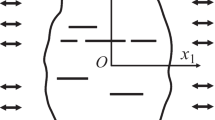Abstract
We study multiple transverse cracking of symmetric laminates in the framework of the variational approach to fracture. Considering the Griffith model, we assume that several cracks can appear instantaneously through the whole thickness of the core layer, separating the bar in n elastic segments. We show that the energy minimization implies the bifurcation from solutions with uniform crack spacing to non uniformly spaced solutions, a phenomenon ignored in the literature for perfect systems. The stability of uniformly spaced solutions crucially depends on the concavity of the elastic compliance of each elastic segment as a function of the segment length. We compute this function and its derivatives numerically with domain-derivative techniques for a large set of geometric and material parameters. Our results indicate that the change of concavity and the related instability is a robust qualitative property that becomes quantitatively relevant in the case of laminates with thin and soft outer layers.













Similar content being viewed by others
References
Alnæs MS, Logg A, Ølgaard KB, Rognes ME, Wells GN (2014) Unified form language: a domain-specific language for weak formulations of partial differential equations. ACM Trans Math Softw 40:2
Berthelot J (2003) Transverse cracking and delamination in cross-ply glass-fiber and carbon-fiber reinforced plastic laminates: static and fatigue loading. Appl Mech Rev 56:111–147
Berthelot J-M, Corre J-FL (2000) Statistical analysis of the progression of transverse cracking and delamination in cross-ply laminates. Compos Sci Technol 60(14):2659–2669
Berthelot J-M, Leblond P, El Mahi A, Le Corre J-F (1996) Transverse cracking of cross-ply laminates: Part 1. Analysis. Compos A: Appl Sci Manuf 27(10):989–1001
Bleyer J, Alessi R (2018) Phase-field modeling of anisotropic brittle fracture including several damage mechanisms. Comput Methods Appl Mech Eng 336:213–236
Bourdin B, Francfort GA, Marigo J-J (2008) The variational approach to fracture. J Elast 91(1–3):5–148
Dvorak GJ, Laws N (1986) Analysis of first ply failure in composite laminates. Eng Fract Mech 25(5):763–770
Francfort G, Marigo J-J (1998) Revisiting brittle fracture as an energy minimization problem. J Mech Phys Solids 46:1319–1342
García IG, Mantiè V, Blázquez A, París F (2014) Transverse crack onset and growth in cross-ply [0/90]s laminates under tension. Application of a coupled stress and energy criterion. Int J Solids Struct 51(23):3844–3856
Hashin Z (1985) Analysis of cracked laminates: a variational approach. Mech Mater 4(2):121–136
Javaland M, Hosseini-Toudeshky H, Mohammadi B (2012) Numerical modeling of diffuse transverse cracks and induced delamination using cohesive elements. Proc Instit Mech Eng C: J Mech Eng Sci. https://doi.org/10.1177/0954406212460974
Leguillon D (2002) Strength or toughness? A criterion for crack onset at a notch. Euro J Mecha A/Solids 21(1):61–72
León Baldelli AA, Babadjian J-F, Bourdin B, Henao D, Maurini C (2014) A variational model for fracture and debonding of thin films under in-plane loadings. J Mech Phys Solids 70:320–348
León Baldelli AA, Bourdin B, Marigo J-J, Maurini C (2011) Fracture and debonding of a thin film on a stiff substrate: analytical and numerical solutions of a one-dimensional variational model. Contin Mech Thermodyn. https://doi.org/10.1007/s00161-012-0245-x
Luenberger D (2008) Linear and Nonlinear Programming
Maimí P, Rodríguez H, Blanco N, Mayugo J (2015) Numerical modeling of matrix cracking and intralaminar failure in advanced composite materials. Numer Modell Fail Adv Compos Mater. https://doi.org/10.1016/B978-0-08-100332-9.00007-4
Manders P, Chou T, Jones F, Rock J (1983) Statistical analysis of multiple fracture in [0/90/0] glass fiber/epoxy resin laminates. J Mater Sci 19:2876–2889
Nairn J (2000) Matrix microcracking in composites. In: Kelly A, Zweben C (eds) Comprehensive composite materials, vol 2. Pergamon, Oxford, pp 403–432
Okabe T, Nishikawa M, Takeda N (2008) Numerical modeling of progressive damage in fiber reinforced plastic cross-ply laminates. Compos Sci Technol 68(10):2282–2289
Parvizi A, Bailey J (1978) Constrained cracking in glass fibre reinforced epoxy cross-ply laminates. J Mater Sci 13:195–210
Puglisi G, Truskinovsky L (2000) Mechanics of a discrete chain with bi-stable elements. J Mech Phys Solids 48(1):1–27
Quintanas-Corominas A, Reinoso J, Casoni E, Turon A, Mayugo JA (2019) A phase field approach to simulate intralaminar and translaminar fracture in long fiber composite materials. Compos Struct 220:899–911
Scroggs MW, Dokken JS, Richardson CN, Wells GN (2022) Construction of arbitrary order finite element degree-of-freedom maps on polygonal and polyhedral cell meshes. ACM Trans Math Softw. https://doi.org/10.1145/3524456
Silberschmidt V (2005) Matrix cracking in cross-ply laminates: effect of randomness. Compos A: Appl Sci Manuf 36(2):129–135
Vinogradov V, Hashin Z (2005) Probabilistic energy based model for prediction of transverse cracking in cross-ply laminates. Int J Solids Struct 42(2):365–392
Acknowledgements
The authors thank Blaise Bourdin and Jean-Jacques Marigo for their advice during this work.
Author information
Authors and Affiliations
Corresponding author
Additional information
Publisher's Note
Springer Nature remains neutral with regard to jurisdictional claims in published maps and institutional affiliations.
Rights and permissions
Springer Nature or its licensor (e.g. a society or other partner) holds exclusive rights to this article under a publishing agreement with the author(s) or other rightsholder(s); author self-archiving of the accepted manuscript version of this article is solely governed by the terms of such publishing agreement and applicable law.
About this article
Cite this article
Karoui, Z., Berthe, J. & Maurini, C. Non-uniform spacing of transverse cracks in symmetric composite laminates. Int J Fract 242, 191–206 (2023). https://doi.org/10.1007/s10704-023-00715-w
Received:
Accepted:
Published:
Issue Date:
DOI: https://doi.org/10.1007/s10704-023-00715-w




